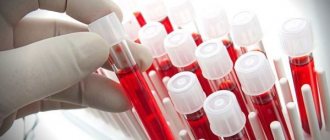Blood is the vital basis of the body, which is a complex transport system that provides tissues with biological substances. The main component of blood is plasma, in which all elements live. Normally, the ratio of all blood cells to plasma is 4:6. If the balance is disturbed during pregnancy, pathological thickening of the blood occurs. This phenomenon in medical practice is called hypercoagulation. This syndrome requires increased attention, since excessively viscous blood leads to disruption of oxidative and regenerative processes, promotes thrombus formation, and impairs cellular respiration. But not all forms of hypercoagulation are considered to be a dangerous condition, and in some situations this condition can be considered a variant of the norm.
Risk factors
There are some conditions that cause bleeding disorders.
Pathology can be caused by several conditions: Lack of water, dehydration. Blood is approximately 85% liquid and plasma is 90%. A decrease in these indicators entails a logical condensation. It is necessary to pay special attention to the drinking regime in warm seasons
It is very important to replenish water reserves during physical activity. Enzymopathy is a disease that is associated with a lack of food enzymes or disruption of their activity. This condition entails incomplete breakdown of food, as a result of which unprocessed breakdown products enter the bloodstream, contributing to its thickening
Unhealthy eating. Many products contain special protein inhibitors that form compounds with proteinases in the digestive system. This causes disruptions in digestion and protein absorption. Unprocessed amino acids are sent into the bloodstream and interfere with its clotting. Pathology can be caused by overeating carbohydrates, sugar and fructose. Lack of minerals and vitamins. Enzyme synthesis requires water-soluble vitamins. Their deficiency provokes poor digestion of food and, as a result, hypercoagulation. Liver dysfunction. Every day, the organ produces approximately 15-20 g of blood proteins responsible for transport and regulatory functions. Deviations in biosynthesis lead to abnormal changes in the composition of the blood.
Among other things, the syndrome may be associated with the presence of any parasites in the body, hyperfunction of the spleen, or injury to blood vessels.
Causes of pathology
Hypercoagulability syndrome usually does not have pronounced symptoms. Most often, patients complain of frequent migraines, general fatigue, and lethargy.
Doctors conventionally divide the causes of the disease into congenital and acquired.
The last category includes:
- bad habits;
- obesity and extra pounds;
- age-related changes;
- pregnancy;
- taking oral contraceptives;
- hormone replacement therapy;
- too high concentration of cholesterol in the blood;
- surgical interventions, or rather, long bed rest after them;
- complete lack of physical activity;
- severe dehydration of the body;
- heavy metal poisoning;
- hypothermia;
- microbial invasions;
- chemical and thermal burns;
- lack of Omega-3 fatty acids.
As for congenital causes, these include unexplained miscarriages, a family history of thrombophilia, and repeated blood clots before the age of 40.
Pathological deviations from the norm
A strong deviation from the norm in the direction of decrease or increase may indicate the development of:
- diabetes mellitus in pregnant women;
- liver and kidney diseases.
Lack of blood clotting inevitably leads to uterine bleeding and miscarriage, and increased clotting leads to the formation of blood clots, which causes insufficient oxygen supply to the fetus and hypoxia (oxygen starvation).
It should be taken into account that a change in coagulogram values is also possible with late toxicosis (preeclampsia), which leads to serious consequences:
- intrauterine growth retardation;
- premature birth;
- placental abruption;
- heart and kidney failure.
In addition, the doctor pays attention to the indicator of antibody formation (lupus anticoagulant). During normal pregnancy it is absent
Its appearance indicates the presence of autoimmune diseases in a woman’s body. As a rule, the time to form one blood clot (aPTT) immediately increases.
Lupus anticoagulant is detected when:
- rheumatoid arthritis (joint damage);
- systemic lupus (a malfunction of the immune system, which causes inflammation in various organs and tissues of the body);
- ischemic stroke (cerebrovascular accident).
Deviation from the norm of this value may indicate:
- development of blood vessel thrombosis;
- placental infarction - a sudden cessation of its blood supply;
- intrauterine fetal death;
- spontaneous abortion.
If treatment with anticoagulant drugs (Warfarin, Phenilin) is carried out, it is necessary to regularly monitor the INR (international normalized ratio) value. This is the ratio of the actual prothrombin time determined during the analysis and the average prothrombin time. The permissible norm is 2.5.
If the pathology is detected on time, the chances of preventing its further development are very high.
A coagulogram is a mandatory blood clotting test that every pregnant woman undergoes. Do not immediately get upset, much less panic, if the indicators deviate slightly from the average values. Listen to your doctor's recommendations to promptly correct any unwanted changes.
Drug therapy
In cases of hypercoagulability, medications are needed to prevent blood clots and thin the blood. Patients are most often prescribed:
- antiplatelet agents – “Thrombo ACC”, “Acetylsalicylic acid”, “Cardiomagnyl”;
- anticoagulants – “Heparin”, “Warfarin”, “Fragmin”;
- fibrinolytics – “Fortelysin”, “Thromboflux”, “Streptase”;
- vitamins C, E and P;
- antispasmodics – “Papaverine”, “No-shpa”, “Spazmalgon”;
- anti-inflammatory drugs - “Indomethacin”, “Ibuklin”;
- vascular agents – “Curantil”, “Pentoxifylline”;
- if a bacterial infection is detected, antibiotics are prescribed - “Gordox”, “Cefazolin”, “Azithromycin”, “Contrical”;
- Steroid hormones are needed for autoimmune diseases - “Dexamethasone”, “Prednisolone”.
If a patient is diagnosed with paraneoplastic hypercoagulation syndrome, a pathology that arises against the background of malignant tumors, surgical intervention is performed. In severe cases, the administration of crystalloid and colloid solutions and donor blood transfusion may be indicated.
Treating thick blood during pregnancy in a gentle way
If possible, a pregnant woman should avoid treatment with medications, otherwise the successful development of her baby remains in question. This recommendation is relevant for the expectant mother and for the diagnosis of blood thickening, therefore the main way to correct this disorder is a special diet. Doctors advise a pregnant patient who has been diagnosed with thick blood to follow these rules:
- Drink plenty of fluids. The doctor determines the required volume individually for each patient, but generally this figure is 1.5 - 2 liters per day. By the way, teas, coffee with milk, compotes and fruit juices do not belong to this volume.
- You need to drink regular clean water – distilled or carbonated water is not suitable. The entire volume should be divided into small portions and taken several sips throughout the day. If you drink a lot at once, the liquid will remain in the body in the form of edema, and the expectant mother does not need it. It is most convenient to purchase bottled water - this way you can easily control the amount of liquid you drink.
- Avoid salt completely or partially - white crystals interfere with the removal of fluid from the body and provoke the development of swelling.
- Diversify your daily diet with products that contain vitamin C, which thins the blood. Ascorbic acid can be found in berries, fruits, red-orange vegetables and freshly squeezed juices.
- Don't forget to eat citrus fruits. You can't do without grapefruit, orange, lemon and lime if you have thick blood.
- Normalize blood viscosity levels with the help of berries. Strawberries, viburnum, raspberries, cranberries, black currants, and mulberries have therapeutic characteristics.
- Replenish your diet with spices: dill, cinnamon, ginger, oregano, paprika, thyme, turmeric, cayenne pepper.
- Be sure to prepare dishes with beets, tomatoes, dried apricots, pineapples, garlic, pomegranate, and onions. Alternate vegetable oils in cooking: rapeseed, olive and flaxseed.
- Avoid foods that increase blood viscosity: bananas, buckwheat, potatoes, soda. You can also add salty, fatty and spicy dishes to this list.
In parallel with making amendments to the daily diet, the expectant mother needs to tone her body with moderate physical activity. Physical activity will have the most positive effect on stimulating blood circulation. A pregnant woman will not get tired at all if she does a few simple gymnastic exercises in the morning and a little later goes for a walk to get some fresh air. Regular exercise is the key to good mood and well-being, a guarantee of the absence of swelling and heaviness in the legs.
Norms and changes in indicators
Despite the individual characteristics of each person, there are special tables that indicate the normal values of blood markers.
Deviations in the data of one or another indicator indicate that a pathological process is developing in the body, which is important to correctly diagnose and restore health to the patient.
A blood test during pregnancy is explained in the following table:
| Name | I trimester | II trimester | III trimester | Changes |
| Hematocrit (hct). Liter per liter. | 0.38 | 0.37 | 0.36 | Shows the content of red blood cells in relation to the total blood volume. A deficiency indicates anemia or bleeding of any kind. Excess indicates the presence of a lack of fluid, which provokes vomiting, diarrhea, gestosis, toxicosis |
| Red blood cells (rbc). Number multiplied by 10/liter. | 4.2 | 3.5 | 3.9 | Shows the number of red blood cells in the taken biomaterial. An increase and decrease indicate the diseases described in the previous paragraph. |
| Hemoglobin (hgb). Gram per liter. | average - 123 (110-140). | 114 (115-135) | 112 (110-120) | During pregnancy, hemoglobin levels decrease due to an increase in blood volume. Low hemoglobin (anemia) provokes fetal hypoxia, IUGR, premature birth and heavy blood loss. High hemoglobin content occurs with dehydration, constipation, hypervitaminosis, folic acid deficiency, and diabetes. |
| White blood cells (wbc). Number multiplied by 10/liter. | 7-7.2 | 7.8-9.9 | 10.4-12.0 | Leukocytes are cells of the human immune system. An increase in indicators indicates infection and progressive inflammation in the body of the expectant mother or fetus. The reason for this is infections such as influenza, otitis media, sinusitis, thrush, genital herpes, cystitis, liver and kidney diseases, meningitis, etc. If the level of leukocytes is low, then the reason for this may be decreased immunity, deficiency of vitamins and microelements, and exhaustion of the female body. In the worst case scenario, a low level indicates a developing autoimmune disease. |
| Platelets (plt). Number x 10/litre. | The general figure is 200-250. | Shows the level of blood clotting. An increase in platelets can be caused by dehydration. It is observed in people prone to the formation of blood clots in blood vessels. If the platelet level is elevated, a coagulogram is additionally prescribed. | ||
| ESR (fw). milliliters per hour. | 12-20 | 25 | 30-34 | The difference in readings is the result of a viral or bacterial disease. |
In addition to the indicators described in the table, the analysis process considers such components as subtypes of leukocytes:
- Basophils (at a norm of 0 - 1%). An increase can be caused by allergies, poisoning, urticaria, smallpox, rubella.
- Eosinophils (0 - 1%). An increase in the number may be infection with helminths, allergic dermatitis or bronchial asthma.
- Neurophiles. The norms for segmented ones are 40-78%, for band ones - 1-6%. An increase in the norm indicates purulent inflammatory processes in the body (inflammation of the appendix, sore throat, etc.), and a decrease indicates infectious diseases.
An upward change in leukocyte levels in pregnant women is provoked by infectious diseases. Norm of lymphocytes during pregnancy (in percent): 28; 26; 26 in the 1st, 2nd, 3rd trimesters, respectively.
Hypercoagulation during pregnancy - causes, symptoms, treatment
Hypercoagulation during pregnancy is increased blood viscosity. The problem arises due to physiological or pathological reasons. Without constant monitoring of the condition and proper treatment, the disease can negatively affect the development of the fetus.
What kind of pathology is this
Hypercoagulation – increased blood clotting, an increase in its density, develops when the balance of plasma and cellular elements is disturbed.
Varieties:
- normal or physiological;
- pathological;
- congenital – inherited;
- acquired - develops against the background of certain diseases.
During pregnancy, the problem occurs in all women.
Why is it dangerous?
With hypercoagulation, the likelihood of developing thrombosis, thrombophlebitis, and varicose veins in pregnant women increases.
https://www.youtube.com/watch?v=bQzBNSK9jrY
Consequences of increased blood clotting during pregnancy:
Increased coagulation causes heart attack, stroke, retinal detachment, and migraines.
When and which doctor to contact
The expectant mother should report any deterioration in her health to her gynecologist. If the tests show signs of increased coagulation, the doctor will issue a referral to a hematologist.
Prevention methods
The rules for preventing hypercoagulation differ little from the usual recommendations for all pregnant women.
How to prevent the problem from developing:
- walk more in the fresh air;
- eat properly and balanced;
- follow a daily routine, get enough sleep;
- ventilate the room several times a day;
- observe the drinking regime, in the absence of contraindications, drink at least 2 liters of clean water per day;
- do morning exercises, play sports, taking into account the gestational age;
- do not be nervous, eliminate all stress factors if possible;
- Visit the antenatal clinic in a timely manner and take all necessary tests.
Hypercoagulation during pregnancy caused by pathological reasons requires immediate treatment. The disease negatively affects the development of the child and provokes the development of other health problems.
Blood thinners can only be prescribed by a doctor; self-medication can lead to severe bleeding and other serious complications.
(1 rating, average 5 out of 5)
Peculiarities
In a normal state, bleeding stops after 3-4 minutes, and after about 10-15 minutes a blood clot appears. If this happens several times faster, one can suspect the presence of hypercoagulation syndrome. According to ICD-10, this pathology is assigned code D65.
This condition is considered very dangerous because it can cause varicose veins, thrombosis, stroke, heart attack and other damage to internal organs. Due to too thick blood, the body experiences a lack of oxygen, which causes general malaise and poor performance. In addition, the likelihood of blood clots increases significantly.
The code for hypercoagulability syndrome according to ICD-10 is D65.
Why is this pathology dangerous?
Very often, doctors do not even attach importance to the fact that a pregnant woman has thick blood. This condition may be a physiological norm and go away on its own after childbirth. By the way, even iron supplements, which are often prescribed to pregnant women with low hemoglobin, can increase blood density.
However, if a woman is found to have thick blood during pregnancy, then a few weeks before giving birth she will need to take an additional test to monitor the indicators (they, by the way, tend to change constantly throughout the entire period).
Therefore, dear women, do not panic if the doctor, based on the results of the coagulogram, decided not to do anything. However, be sure to listen to his recommendations when he prescribes you treatment for thick blood during pregnancy. The fact is that such a condition can also pose a great danger to the baby and his mother. This is mainly the risk of blood clots (after childbirth, varicose veins often “come out” if there was thick blood during pregnancy) and blockage of blood vessels, as a result of which both suffer: the fetus experiences a lack of oxygen, the risk of miscarriage, heart attack, stroke increases, and in general disruption of normal blood circulation is fraught with multiple consequences.
But the good news in this case is that the situation can be corrected.
Blood clotting: what is it?
Before we talk about the reasons for increased coagulability (thick blood) during pregnancy and the possible consequences for the child and the mother herself, let’s define the concepts. Let's start with the basics. First, let's figure out what blood clotting is.
Blood clotting or coagulation is a biological defense reaction of the body that allows one to maintain the required amount of blood in the vascular bed and prevent death from blood loss when the integrity of blood vessels is compromised.
There are two main mechanisms for stopping bleeding: primary hemostasis, also called vascular-platelet, and secondary or coagulation. Primary stops bleeding from small-diameter vessels. When the vascular wall is traumatized, a sharp contraction of the vessel occurs and the defect is blocked by the formed elements of blood with platelets, which, sticking together, form a white thrombus.
The essence of secondary hemostasis is the transition of fibrinogen dissolved in plasma into fibrin through a series of preliminary enzymatic transformations. The result of this process is the formation of a red blood clot, consisting mainly of erythrocytes (red blood cells) and fibrin strands.
Coagulation, being an enzymatic multi-stage process, depends on various factors. When a vessel is damaged, it is activated by tissue factors and regulated by coagulation factors, contained mainly in plasma and platelets (13 plasma and 22 platelets).
In addition to substances that promote coagulation, the so-called coagulants, the vascular bed contains anticoagulants that limit or slow it down. In addition, there are substances in the blood that trigger and inhibit fibrinolysis (the process of dissolving blood clots and blood clots). This entire complex system ensures that the blood is in a liquid state, and at the same time stopping the bleeding, followed by the dissolution of unnecessary clots.
Is thick blood during pregnancy dangerous for the woman and fetus?
Having identified a change in blood density in a pregnant woman, the doctor assesses the degree of these disorders and determines the tactics for managing the patient.
It is based on the results of a coagulogram that a specialist will be able to determine the degree of danger of blood thickening during pregnancy. In some cases, with minor changes in indicators, the doctor does not attach serious importance to blood density and gives the woman general recommendations regarding diet and fluid intake aimed at eliminating this symptom. In such situations, you should not worry, because such blood thickening does not pose a threat to either the expectant mother or the fetus, and after childbirth, the coagulogram indicators stabilize on their own.
Sometimes the cause of blood thickening during pregnancy is taking iron-containing drugs, which are prescribed when hemoglobin levels decrease. Such a symptom should also not cause concern in a woman, because after eliminating anemia and discontinuing these medications, the blood condition will stabilize.
For more serious changes in coagulogram parameters, the doctor may recommend that the pregnant woman undergo a course of blood thinning therapy. In such situations, a woman should also not worry, but simply follow all the doctor’s orders. The danger of such blood thickening lies in the increased risk of blood clots and obstructed blood flow through the vessels, but this situation can be corrected.
The slow flow of viscous blood through the vessels and a more intense load on the heart causes insufficient supply of oxygen and nutrients to all tissues and organs. This leads to the following symptoms in a pregnant woman:
- constant lethargy;
- memory impairment;
- drowsiness;
- dry mouth;
- heaviness in the legs;
- coldness of the extremities.
With a sedentary lifestyle and lack of treatment, an increased tendency to blood clots can lead to the development of the following complications in the expectant mother:
- thrombosis;
- thrombophlebitis;
- TELA;
- varicose veins;
- diseases of the cardiovascular system (heart attack, hypertension, stroke, atherosclerosis).
Significantly increased blood density also negatively affects the condition of the unborn baby. As a result of increased thrombus formation and slow blood flow, the following disorders may occur on the part of the fetus:
- miscarriage or premature birth;
- frozen pregnancy;
- hypoxia;
- developmental delay.
It is in connection with the above possible complications of thick blood that women planning a pregnancy should refuse to conceive until the course of treatment for this condition is completed. In some cases, this disorder in the blood coagulation system can be life-threatening for the expectant mother and baby, and not all medications can be taken by a woman while carrying a child. Therefore, it is better to get rid of this symptom before pregnancy.
When planning a conception, the doctor will definitely prescribe a coagulogram to rule out disorders in the blood coagulation system. It is especially important to conduct such a study in certain risk groups:
- the woman has a history of miscarriages or missed pregnancies;
- the woman or her relatives have varicose veins;
- close relatives of the woman had thrombosis, heart attacks or strokes;
- a woman professionally engages in sports that involve intense physical activity.
Symptoms of the disease
The described phenomenon is not accidental, it does not appear quickly and spontaneously. The provoking factor, namely blood thickening, can be represented by the following situations:
Chronometric hypercoagulation is often diagnosed in women carrying a child. This condition is normal, since the body of the expectant mother develops protective qualities before the upcoming birth, and blood clotting increases accordingly.
During pregnancy, the level of fibrinogen in the blood can increase by 1.5-2 times, if we compare the current and previous indicators. But there are cases when the coagulation rate increases many times over. This phenomenon cannot be ignored, since fetal death may occur in the early period and premature placental abruption in the later period. In medicine, hypercoagulation syndrome is known, which is the reason for the full and proper course of pregnancy.
There are main reasons for blood thickening during pregnancy that are worth paying attention to. In particular, these are:
- cardiovascular diseases;
- changes at the gene level associated with hemostasis;
- kidney disease;
- constant depression and stressful situations;
- woman's age exceeding 40 years.
To carefully monitor hemostasis, which is necessary during pregnancy, it is recommended to undergo procedures such as a coagulogram. If a pathology is detected, treatment is mandatory. Timely detection of the syndrome of the described disease will prevent complications in the development of the fetus.
Treatment
To restore normal blood flow and get rid of hypercoagulation, you need to visit a specialist who will conduct a diagnostic examination and provide qualified assistance. Doctors will individually select a treatment regimen taking into account all the characteristics of the body.
- Medicines that thin the blood: medicines based on aspirin that prevent blood clots: antiplatelet agents - Thrombo ACC, Cardiomagnyl, Acetylsalicylic acid; anticoagulants - “Warfarin”, “Heparin”, “Fragmin”; fibrinolytics - Thromboflux, Fortelysin, Streptase.
- Symptomatic therapy - antispasmodics “No-shpa”, “Papaverine”, “Spazmalgon”; anti-inflammatory drugs - "Ibuklin", "Indomethacin", vascular drugs - "Pentoxifylline", "Curantil".
- If there is a bacterial infection in the body, antibacterial therapy is carried out with the addition of antiproteases, for example, Cefazolin and Contrikal, Azithromycin and Gordox.
- To mitigate the developing state of shock, saline solutions, plasma with heparin, Reopoliglucin, and albumin solution are administered intravenously.
- With the development of anemia and a decrease in hematocrit, transfusions of red blood cells or suspension are performed.
- For autoimmune diseases, plasmapheresis is performed and steroid hormones are prescribed - Prednisolone, Dexamethasone.
In severe cases, patients are given intravenous drips of colloidal and crystalloid solutions and transfused with donor blood. Donor blood transfusions save the lives of patients after injuries accompanied by blood loss.
In parallel with traditional drug therapy, traditional medicine recipes are used. Meadowsweet tincture, according to herbalists, is a substitute for aspirin. This plant is used to treat not only blood diseases, but also the cardiovascular system. A decoction prepared from the fruits of hawthorn, meadow clover, valerian root, lemon balm, and yellow clover improves the condition of blood vessels and has a beneficial effect on the blood circulation process.
Diet therapy requires eating natural foods prepared by boiling, stewing or steaming. Products enriched with vitamin E restore blood fluidity. It is good to eat a tablespoon of sprouted wheat grains a day. The diet of patients must include fermented milk products, vegetables, fruits, meat and fish dishes, and seafood. The most useful berries and fruits are: cranberries, currants, cherries, grapes, apples, citrus fruits, peaches. You should definitely exclude canned, smoked, fatty, fried and pickled foods, sweets, baked goods, buckwheat, potatoes, alcohol, and soda.
Patients suffering from hypercoagulability should follow the basic recommendations of specialists:
- Quit smoking
- Eat properly,
- Walk a lot in the fresh air
- Exercise,
- Optimize your daily routine
- Get enough sleep
- Avoid stressful situations and conflicts,
- Lead a healthy lifestyle,
- Get blood tests periodically.
The prognosis of hypercoagulation syndrome is ambiguous and depends on the severity of the underlying disease, the general condition of the body, and existing changes in hemostasis.
Prevention of hypercoagulation involves identifying patients at risk - pregnant women, the elderly and people with cancer, as well as treating the underlying disease.
To be or not to be a diet?
For those patients who have been diagnosed with hypercoagulation, doctors recommend reconsidering their diet.
The following categories of products should be excluded or reduced from the menu:
- Low-fat fermented milk products;
- Meat and fish dishes;
- Dark chocolate and cocoa;
- Vegetables (tomatoes, cucumbers, beets);
- Fruits (lemons, oranges, apples, peaches);
- Berries (cherries, cranberries, currants).
It is important that food is cooked by boiling, stewing or steaming.
Doctors advise eating 1 tablespoon of sprouted wheat grains once a day.
They are able to change blood flow for the better.
Diagnosis at home
It will be difficult for a pregnant woman to independently identify such a problem, because physiological discomfort may not necessarily be associated with an increase in blood viscosity
Therefore, at the first signs of thick blood, it is important to consult your doctor as soon as possible and undergo the necessary tests.
At home, a coagulogram can be done using a portable coagulometer
On the other hand, the modern medical equipment market offers convenient and simple devices for performing coagulograms at home - coagulometers. These devices allow you to determine the prothrombin time (blood clotting time) and the level of prothrombin in the blood.
The device comes with sterile needles, which are used to make a painless puncture on the finger. Next, the biomaterial is applied to the test strip supplied with the coagulometer (3–5 pieces in a package), which is placed in a special guide hole.
The analysis is carried out in one and a half to two minutes, the result is displayed on the display. Test strips have a certain expiration date, so they can be shown to your doctor if necessary.
Analyzes and examinations
Most often, thick blood in a pregnant woman is detected during a routine blood test for a general analysis. Or the doctor may refer the expectant mother for such an examination due to the woman’s complaints of poor health. If concerns are confirmed, a detailed coagulogram is prescribed, which allows obtaining accurate data on the state of the pregnant woman’s blood.
General blood analysis
The biomaterial is taken from the finger or vein of the expectant mother and examined for an increase in the number of blood cells (in particular, red blood cells). If the values are higher than (3.6–5.7) x 1012 cells/liter of blood, the pregnant woman is referred for further examination and appropriate treatment is prescribed.
Complete blood count - a mandatory examination during pregnancy
An increase in blood viscosity is also indicated by:
- high hemoglobin - in the first trimester more than 160 g/liter, in the second trimester above 144 g/liter, in the third trimester - from 141 g/liter;
- increased platelet volume - the norm provides for a figure of 320x109 cells/l, although a maximum number of 400x109 cells/liter is allowed;
- an increase in erythrocyte sedimentation time (ESR) - an acceptable rate of 45 mm/hour; if the time is longer, it means that the blood plasma has become viscous.
Pay attention to the level of hematocrit (the norm is 31–49%), its increase indicates an increase in blood viscosity due to a large number of red blood cells, dehydration or edema
Coagulogram
This is the main type of examination, which consists of a comprehensive study of blood coagulation function. A clotting test is carried out in the morning strictly on an “empty stomach”. In addition, 3 days before visiting the doctor, you should stop using aspirin-based medications, since this substance may affect the test result.
A coagulogram involves a comprehensive study of the composition and properties of the blood of pregnant women
The pregnant woman's blood is taken from a vein, after which the biomaterial is sent to the laboratory.
The data obtained includes the following information about the blood condition of the expectant mother:
- fibrinogen level - in the first and second trimester the indicator fluctuates between 2–4 g/liter, in the third trimester it increases to 6 g/liter, an excess means the likelihood of the formation of a framework for a blood clot;
- the amount of prothrombin - the normal volume is 77–141% (if the amount of this protein is higher, then there is a danger of placental abruption);
- clotting time (prothrombin time) - a normal value of 11 seconds will be, a shorter period indicates a high probability of blood clots;
- lupus anticoagulant - this G-class immunoglobulin is usually absent, otherwise there is a genetic autoimmune disease (systemic lupus erythematosus or antiphospholipid syndrome);
- clotting time under the influence of calcium chloride and other reagents (APTT) is 21.1–36.5 seconds; if the value is less, then clots form.
Other prerequisites for development
Hypercoagulation syndrome most often has a congenital character, but it may well develop against the background of the influence of external conditions. There are several factors under which the occurrence of the disease cannot be ruled out:
- prolonged neuroses and stress;
- vascular damage;
- oncology;
- erythremia;
- antiphospholipid syndrome;
- Wellebrand's disease;
- contact of plasma with foreign surfaces;
- hematogenous thrombophilias;
- impressive hemangiomas;
- postpartum period and pregnancy;
- autoimmune disorders - lupus erythematosus, aplastic anemia, thrombocytopenic purpura;
- atherosclerosis of the coronary arteries;
- severe bleeding from the digestive tract;
- taking estrogen during menopause;
- use of contraceptive pills;
- synthetic heart valve and hemodialysis.
Pathology can be caused by several factors at once. Treatment of hypercoagulability syndrome largely depends on the causes of its occurrence.
Hypercoagulability syndrome during pregnancy
Hypercoagulability syndrome is a condition in which blood thickening occurs. Severe disturbances in the hemostatic system can cause spontaneous miscarriage, premature birth, bleeding and other serious complications during pregnancy.
Blood thickening: normal or pathological?
Before talking about pathology, you should understand one very important thing. During pregnancy, all women experience physiological blood thickening. This phenomenon is considered completely normal, does not lead to complications and does not require treatment. Changes in the blood coagulation system occur in the second and third trimesters of pregnancy.
It happens that changes in the hemostatic system do not fit into the norm established specifically for pregnant women. In this case, they talk about the development of hypercoagulation syndrome. And only in this situation can hypercoagulation become dangerous for the woman and the fetus and lead to the development of serious complications.
Causes of hypercoagulability during pregnancy
Hypercoagulability syndrome can be congenital or acquired. The tendency to increased blood clotting is inherited. When examined, such women are found to have a defect in some genes responsible for normal blood clotting. As a result, a failure occurs in the hemostasis system. The blood thickens, and all the typical manifestations of hypercoagulability syndrome occur.
Pathology of the hemostatic system is not always associated with a gene defect. This condition can gradually develop throughout life. There are several risk factors for the development of hypercoagulation in pregnant women:
- connective tissue dysplasia;
- metabolic syndrome (obesity combined with impaired carbohydrate metabolism);
- autoimmune diseases (antiphospholipid syndrome);
- oncological diseases;
- taking certain hormonal medications;
- prolonged bed rest and immobility.
Antiphospholipid syndrome (APS) deserves special attention. With this pathology, pathological activation of platelets occurs and the activation of blood clotting mechanisms occurs. This pathology can lead to termination of pregnancy at any stage or even cause infertility. APS is also considered one of the risk factors for the development of venous thrombosis. Consequences of hypercoagulation syndrome
Pathology in the hemostatic system may not affect the general condition of a pregnant woman. Many expectant mothers are not even aware of the problem until dangerous complications develop:
- termination of pregnancy at any stage;
- regressing (non-developing) pregnancy;
- placental abruption and bleeding;
- intrauterine fetal death;
- deterioration of uteroplacental blood flow;
- placental insufficiency;
- delayed fetal development;
- gestosis;
- bleeding during childbirth.
Outside of pregnancy, hypercoagulation can cause heart attacks and strokes, retinal detachment, severe migraine attacks and other vascular complications. Pathological blood clotting is also a provoking factor for the development of vein thrombosis of various locations.
The list seems frightening, but pregnancy against the background of hypercoagulability syndrome is not always difficult. With minimal changes in the hemostatic system, it is possible to give birth to a healthy child at the appointed time. In case of severe disorders of the blood coagulation system, special treatment is carried out.
Principles of treatment
In case of pronounced changes in the hemostatic system, anticoagulants are prescribed - drugs that reduce the likelihood of blood clots. Low molecular weight heparins have this property. The drug is administered subcutaneously. The course of therapy is at least 10 days. After treatment, it is necessary to take a hemostasiogram again and evaluate the effectiveness of therapy.
Antiplatelet agents are also used to correct hypercoagulability syndrome. These drugs inhibit platelet aggregation (sticking together) and thereby reduce blood viscosity. The dosage and long-term therapy are determined by the doctor.
All blood thinning medications are used only as prescribed by a doctor. Self-use of medications can lead to bleeding and other serious complications.
obstetrician-gynecologist Ekaterina Sibileva
Hypercoagulation in pregnant women
Moderate hypercoagulation during pregnancy is a common and natural phenomenon. Indeed, during this period, the activity of the blood coagulation system of the mother and unborn child is greatly increased. Hypercoagulability syndrome prevents the patient from large blood loss during the birth process.
Chronometric hypercoagulation is observed starting from the second trimester of pregnancy.
Various factors that are not related to the latter’s lifestyle can provoke pathological hypercoagulation in a pregnant woman:
- Diseases of internal organs (renal apparatus, liver, heart and blood vessels);
- Nervous shocks (stress, depression);
- Mutations at the gene level;
- Patient's age (usually over 40 years).
To avoid the negative consequences of hypercoagulation, changes in hemostasis in a pregnant woman should be under medical supervision. It consists of monthly blood donation for coagulation and clotting tests. If the diagnosis is confirmed, diagnostics are carried out every 2 weeks.
If signs of hypercoagulation are detected, the patient is prescribed drug therapy that is safe for the fetus.
It will be able to protect against thrombosis of the spiral arteries, which is the cause of several serious complications:
- Fetal development is delayed;
- The placenta wears out too quickly;
- The fetus dies during pregnancy.









